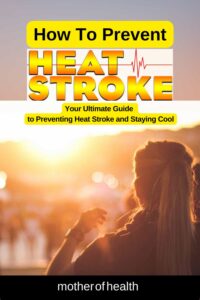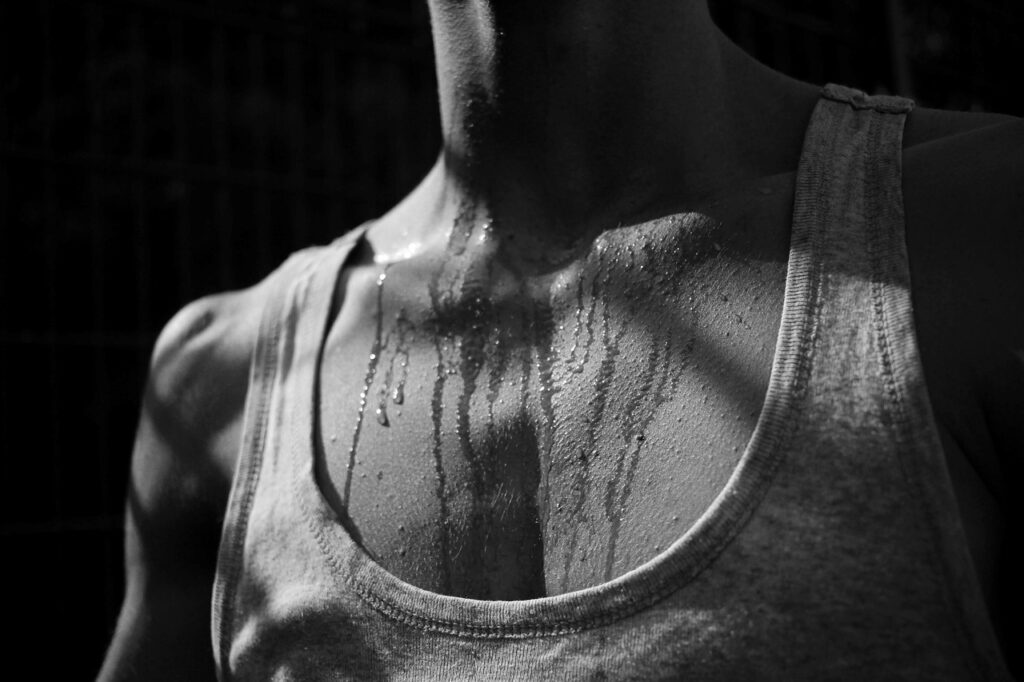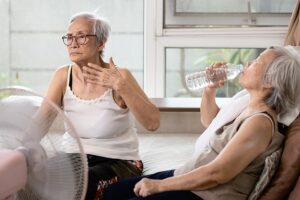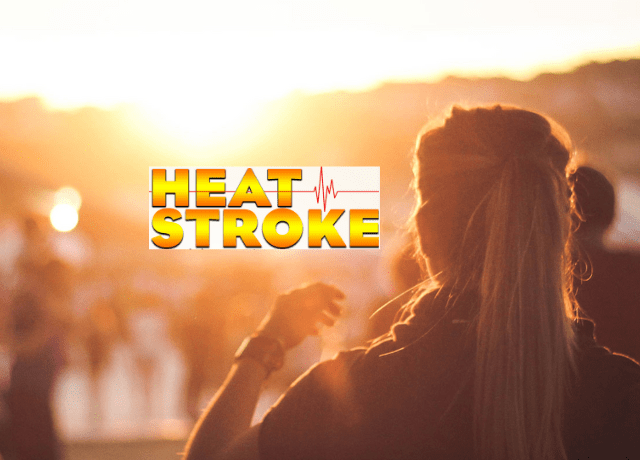Welcome to our guide on how to prevent a heat stroke, so you can stay safe and healthy during the scorching summer days ahead.
In this article, we will delve into effective methods that will help you beat the heat and enjoy the summer with confidence. Keep reading to discover valuable tips that will keep heat stroke at bay and what to do in heat related emergencies.


What is Heat Stroke?

Heat stroke is a potentially life-threatening condition. It occurs when the body's internal temperature rises to dangerous levels – typically above 104 degrees Fahrenheit (40 degrees Celsius).
Heat stroke is no joke. It's not just a matter of getting out of the sun and into the shade, chugging some water, and hoping for the best. Your body can't get rid of the internal heat, which can cause temperatures to skyrocket to over 104°F! Your body loses its ability to cool itself, and you become dangerously dehydrated.
This condition requires immediate medical attention. It can lead to organ damage, brain dysfunction, and in extreme cases, even death.
Who are High-risk People Susceptible to Heat Stroke?

Sweating is an automatic response to high temperatures, but with heat stroke, your body is robbed of its fluids and dehydration sets in. Replenishing your body with the liquids it needs is the only way to avoid heat stroke symptoms.
Wearing dark and heavy clothing in high temperatures increases the likelihood of heat stroke.
People with certain physical or mental conditions are more vulnerable to this condition.
Babies and kids
Babies and kids need adults to help keep them cool and hydrated. They are more susceptible to heat stroke and other heat-related illnesses due to their higher surface area to body mass ratio. This means they absorb more heat from the environment. Plus, they don't sweat as efficiently as adults, so it takes longer for them to start sweating and they don't realize when they're getting dehydrated.
People over 65 years or older
Seniors aged 65 and above often have a tougher time when it comes to dealing with extreme temperatures. They may not be able to recognize the signs of overheating quickly enough.
Also some medications can interfere with the body's ability to stay hydrated and cope with stress. So, it's important for us to keep an eye out for our elderly loved ones and make sure they're staying safe and cool.
People With Chronic Medical Conditions
Those with chronic medical conditions are more susceptible to heat related issues like:
- Poor circulation
- Obesity
- Fever
- Dehydration
- Heart disease
- Diabetes
- Breathing problems
Also those without air conditioning
Statistics show that people with an AC in their home are less likely to suffer from heat-related illnesses. So, if you don't have one, it might be worth considering investing in one!
Athletes
When considering how to prevent a heat stroke, the Center for Disease Control and Prevention (CDC) reports that the leading cause of death among athletes who train or even compete in high temperatures during the late summer and early autumn months is from heat-related illness
Those who work in the great outdoors, particularly in scorching climates, are at risk of heat-related illnesses.
The National Institute of Occupational Safety and Health has warned that fire-fighters, farmers, construction workers, soldiers and manufacturing workers who work around process-generated heat are particularly vulnerable.
Additionally, it's wise to avoid activities that put you at risk of heat stroke or heat-related illnesses, like exercising in the scorching sun.
Four Stages of Heat Stroke
Heat-related illnesses can be sneaky and usually come in four stages.
First, you might faint, followed by muscle cramping, then heat exhaustion, and if you don't take action, heat stroke.
Let’s see what they entail:
1. Fainting from heat, can occur when the body is trying to cool itself down. This causes the blood vessels to widen, reducing the blood flow to the brain. It's common for those working in hot temperatures to experience this. Besides fainting, people may feel dizzy, restless, and nauseous before they faint.
2. Heat cramps are a tell-tale sign of heat-related illnesses, often masquerading as simple muscle aches. Even if you weren't doing anything too strenuous, it's important to take cramping and muscle aches seriously as they can be signs of dehydration. So if you start feeling any of these symptoms, it's best to get out of the sun and start drinking some water to avoid the situation getting worse.
3. Heat exhaustion is like a warning sign that the heat is getting to you. You might start to feel nauseous, weak, and have a pounding headache. You could be sweating profusely, feeling cold and clammy, and even pale. Vomiting may also be a symptom, and if it's not treated, it could lead to heat stroke. So if you start to feel any of these signs, take it seriously and cool down.
4. Heat stroke is a serious medical emergency that can have major repercussions. Symptoms of heat stroke include confusion, dizziness, nausea, and a dangerously high body temperature. If you or someone you know experiences these symptoms, seek medical help immediately – heat stroke can cause brain damage, organ failure, and even death.
What are the first signs that someone is suffering from heat stroke?
- Their body temperature sores above 103° Fahrenheit
- Their pulse is racing
- They're breathing is shallow
- The skin is red, hot, dry, and maybe even moist
- They have a pounding headache
- They are utterly drained and exhausted
- They are not sweating despite the heat
- Nausea and vomiting have set in
- Their muscles are weak and cramping
- Their urine is dark
- They are delirious, disoriented and having seizures
- In some cases, they may be unconscious
Heat stroke can be incredibly serious and even deadly. Research shows that around 20% of people who suffer from it can experience permanent brain damage.
When the body overheats, it causes the blood vessels to dilate and the heart to work harder.
Heat Stroke Requires Quick Action
If someone is suffering from a heat stroke, it's time to take action! Get them help right away by calling 911 or your local emergency services. In the meantime, you can start cooling them down while you wait for help to arrive. Don't delay – act fast!
- Move the person out of the sun and lay them down with their head slightly elevated ASAP
- Help them out by removing or loosening tight or extra layers of clothing
- Encourage them to drink cool water or an electrolyte drink if they are conscious and not experiencing nausea
- To cool them down, you can submerge them in a tub of cool water
- Sponge them off with cool water, and use a fan to circulate the air
- You can also apply ice packs or towels that have been soaked in cool water to their head, neck, groin, and armpits to help them cool off
- Heat cramps can be alleviated by gentle stretching and massaging of the affected muscles
How The Body Regulates Temperature
The human body is a remarkable system that works diligently to maintain its temperature within a narrow and optimal range. This process, known as thermoregulation, is crucial for our overall well-being,
Thermoregulation is primarily controlled by the hypothalamus in the brain. When the body gets too hot, blood vessels near the skin's surface dilate, allowing more blood to flow closer to the skin and release heat through perspiration. As sweat evaporates from the skin's surface, it absorbs excess heat, effectively cooling the body down.
Conversely, in colder conditions, blood vessels constrict to minimize heat loss, and muscles may shiver to generate additional warmth.
By continuously fine-tuning these mechanisms, our bodies ensure that our core temperature remains relatively stable, enabling us to adapt to a wide range of environmental conditions and stay healthy.
Recognizing the Effects of Dehydration
Recognizing the effects of dehydration is essential during hot weather or physical exertion.
The early signs of dehydration may include:
- Increased thirst
- Dry mouth
- Darker urine with reduced frequency of urination
As dehydration progresses, there may be symptoms like fatigue, dizziness, headaches, and dry, cool skin. In severe cases, dehydration can lead to rapid heartbeat, sunken eyes, confusion, and even fainting.
Recommended Fluid Intake During Hot Weather
The recommended fluid intake can vary based on individual factors such as age, activity level, and overall health. But, as a general guideline, it's advisable to aim for at least 8 to 10 cups (64 to 80 ounces) of fluids per day for adults.
Water should be the primary source of hydration. Herbal teas, diluted fruit juices, and low-sugar electrolyte drinks can also contribute to fluid intake.
Engaging in outdoor activities or exercise in hot weather may increase the need for fluids. It's essential to drink before, during, and after physical exertion.
Paying attention to thirst cues and monitoring urine color are helpful indicators of whether you are consuming enough fluids. By maintaining an adequate fluid intake, you can help keep your body cool, energized, and ready to embrace the joys of summer safely.
Conventional Heatstroke Treatments
Cooling down quickly and restoring body temperature and brain function to normal within an hour usually leads to a full recovery.
Medical professionals will take a rectal temperature to determine if the issue has progressed to heat stroke or not.
Following that, the patient will be provided with IV hydration and then taken to the hospital if they haven't been rushed there already. The IV hydration will carry on for 24-72 hours. If the heat stroke is severe, the medical professional may administer IV magnesium sulfate to help ease any muscle cramping.
How To Prevent Heat Stroke Naturally

Drink Adequate Water
To avoid heat stroke, it's important to stay hydrated. Make sure to drink two to four cups of water every hour you're outside or exercising. Don't wait until you're thirsty to start drinking – by then you've already become dehydrated and you're at risk for heat stroke. Staying hydrated is key to avoiding the heat.
Don't forget about your furry friends! Heat stroke can affect cats and dogs, too. If you notice signs of lethargy, panting, or unresponsiveness in your pet, contact your vet right away. Just like humans, they need to be treated quickly to avoid serious consequences.
Stay Hydrated with Fruits and Veggies
Fruits and vegetables are a great way to stay hydrated and avoid heat stroke. Not only do they have a high water content, they also contain electrolytes that help your body stay balanced. So, make sure to stock up on these hydrating foods to stay cool and healthy!
- Watermelon
- Coconut water
- Grapefruit
- Orange
- Pineapple
- Banana
- Berries
- Grapes
- Kiwi
- Bell peppers
- Cucumber
- Carrots
- Zucchini
- Tomatoes
- Avocado
- Radishes
- Iceberg lettuce
- Broccoli
Electrolytes are essential for keeping your fluids in balance and your blood pressure in check. Magnesium, calcium, and potassium are the stars of the show – they're packed with electrolytes that your body needs.
Ditch the Booze, Coffee and Sugary drinks
Not only do these drinks make you pee more and cause electrolyte loss, but sugary drinks can also cause inflammation and make heat stroke symptoms worse. Instead of reaching for those sports drinks, why not try some natural electrolytes? They're a much better option for keeping hydrated.
Avoid Direct Sunlight
When the sun is out, it's important to be mindful of how much time you spend in direct sunlight. On especially hot days, try to stay in the shade as much as possible. If you find yourself in an open area, bring an umbrella to shield yourself from the sun. If you're working out outdoors, aim to do it in the later hours of the day when the temperature is more bearable.
Stay in an Air-conditioned Building
When the heat is unbearable, it's essential to stay in an air-conditioned building. Fans and open windows may provide some relief, but they don't compare to air conditioning.
If you don't have AC at home, try to find a cool shelter in your community. Shopping malls, theaters, libraries, restaurants, and community centers are all great places to escape the heat.
To bring your temperature down, take a cold shower or bath, apply cool compresses to your head or neck, wear lightweight clothing, and avoid strenuous activities.
Check Your Medications
Certain medications can actually increase your risk of heat stroke.
Some pharmaceuticals can interfere with your body's ability to regulate its temperature, as well as your salt and water balance. Think antibiotics, antihistamines, antidepressants, blood pressure meds, cholesterol meds, laxatives – the list goes on.
If you're on any of these, chat with your doc about the potential for heat-related illnesses. And when the weather's hot, make sure you stay extra hydrated and cool, especially if you're on certain meds.
Never Leave a Pet or a Person in a Parked Car
Leaving a pet or a person in a parked car is never a good idea. It can be a deadly mistake. When the car is parked in the sun, the temperature can rise a shocking 20 degrees in just 10 minutes! Make sure you lock your car when you park it, to keep kids and pets safe.
Dressing for Hot Weather
Choose Appropriate Clothing materials and colors
The right clothing materials can make a significant difference in keeping cool and comfortable. Opt for lightweight and breathable fabrics like cotton, linen, or moisture-wicking synthetic. These fabrics allow air to circulate around your body, aiding in sweat evaporation.
Avoid heavy and tight-fitting clothes that trap heat and hinder proper ventilation. Additionally, consider wearing light-colored clothing, as it reflects sunlight and reduces heat absorption, helping you stay refreshed under the scorching sun.
Wear Sunscreen and Hats
Shielding your skin from the sun's rays is crucial in preventing sunburn and reducing heat-related risks. Before stepping out, generously apply a broad-spectrum sunscreen with a high SPF to exposed areas of skin.
Don't forget to cover your face and neck with a wide-brimmed hat to protect against direct sunlight.
Using cooling accessories:
Beat the heat with the help of cooling accessories that can work wonders in regulating body temperature.
A lightweight and moisture-wicking headband, neck gaiter or bandana can be soaked in cold water and worn around your neck to provide instant relief.
Additionally, consider using a handheld or battery-operated fan to create a refreshing breeze when the temperatures soar.
Cooling towels are also a great option, as they hold water and stay cool for an extended period, making them perfect companions for outdoor adventures and workouts. With the right clothing and accessories, you can conquer hot weather challenges and enjoy the summer months with ease.
Creating a Cool Living Space
Not everyone has access to air conditioning, but there are several effective ways to keep your living space cool during hot weather.
During the day, close curtains and blinds to block out direct sunlight, which can significantly heat up rooms.
Open windows in the evening and early morning to allow cooler air to circulate. Use fans strategically to promote airflow.
To further reduce indoor temperatures, avoid using heat-generating appliances like ovens and stoves. Opt for cooler cooking methods such as grilling or preparing refreshing salads.
Proper use of Fans and Ventilation
If you don't have air conditioning, fans are excellent tools for enhancing ventilation and promoting air circulation.
Position box fans or oscillating fans near windows to draw in cooler outdoor air and push warm air outside. To maximize their cooling effect, place a bowl of ice in front of the fan, creating a makeshift air conditioner.
Additionally, ceiling fans can be set to rotate counterclockwise during the summer months, pushing air downwards and creating a comfortable breeze throughout the room.
Cooling Techniques for Outdoor Activities
While indoor cooling is crucial, enjoying outdoor spaces during hot weather requires a few tricks to beat the heat. Setting up shaded areas with canopies, umbrellas, or pop-up tents provides respite from direct sunlight.
Consider using cooling misting fans or personal misters to stay cool when lounging or engaging in outdoor activities. Another refreshing idea is to create a DIY water play area with sprinklers, water balloons, or inflatable pools to cool off and have fun with family and friends.
By employing these strategies, you can turn your living space into a cool sanctuary during scorching summer days, ensuring a comfortable and enjoyable environment for all.
What is the Difference Between Heat Stroke and Heat Exhaustion?
Both conditions can occur when exercising in hot and humid weather, and can cause severe dehydration.
Heatstroke is the more serious of the two and usually follows heat exhaustion if it is not treated. Symptoms of heatstroke include a high body temperature, vomiting, nausea, dizziness, headaches, rapid heartbeat, fatigue, dry and hot skin, and shortness of breath with decreased urination.
Heat exhaustion, on the other hand, is usually accompanied by a fever that doesn't usually exceed 104 degrees Fahrenheit. Other symptoms include excessive thirst, fainting, nausea, cool and clammy skin, muscle aches and weakness, heavy sweating, dizziness, and a slow heartbeat.
The Prognosis for Heat Stroke
The prognosis for heat stroke is generally good if the person receives prompt and effective treatment. Most people will make a full recovery, although they may become more sensitive to hot weather.
Usually, a hospital stay of two days is required, although if there is organ damage, a longer stay may be needed.
Complete recovery, however, can take up to a year and may involve long-term effects on the patient's health if complications arise. In severe cases, brain and organ damage can be permanent, so it's important to seek help as soon as possible.
Before you Go
Preventing heat stroke is not merely an option; it's essential to safeguard your health. By knowing how to prevent a heat stroke you equip yourself with the knowledge and tools to enjoy warm summer days.
Stay hydrated, dress wisely for hot weather, and create a cool living space both indoors and outdoors.
Whether you're embarking on outdoor adventures or simply enjoying the sun's warmth, these preventive measures will allow you to revel in summer's delights without compromising your well-being. With these tips, you're ready to conquer any heatwave and ensure a safe, enjoyable season filled with cherished memories.
Recognize the early signs of dehydration and heat-related emergencies, and never hesitate to seek medical attention when needed.


